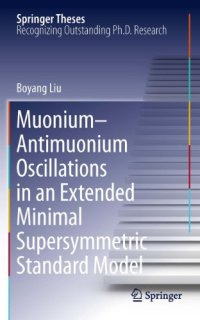
Ebook: Muonium-antimuonium Oscillations in an Extended Minimal Supersymmetric Standard Model
Author: Boyang Liu (auth.)
- Genre: Physics // Mechanics: Oscillations and Waves
- Tags: Elementary Particles Quantum Field Theory, Quantum Field Theories String Theory, Mathematical Methods in Physics
- Series: Springer Theses 2
- Year: 2011
- Publisher: Springer-Verlag New York
- Edition: 1
- Language: English
- pdf
The muonium-antimuonium oscillation process has been studied for decades both experimentally and theoretically. Of particular interest is that such a muonium-antimuonium oscillation is totally forbidden within the Standard Model because the process violates the individual electron and muon number conservation laws by two units. Hence, its observation will be a clear signal of physics beyond the Standard Model.
This thesis involves the computation of the muonium-antimuonium oscillation time scale in a variety of Standard Model extensions. First, the gauge independence of the various 1-loop contributions to this process is demonstrated in the Standard Model modified only with the inclusion of right-handed neutrinos which were used to generate light neutrino masses via the see-saw mechanism. Next the muonium-antimuonium oscillation time scale in a supersymmetric (SUSY) extension of the Standard Model is calculated. The lower bound on the ratio of the two Higgs field VEVs is also discussed by using experimental results.
This Doctoral Thesis has been accepted by Purdue University, West Lafayette, USA.
This innovative work investigated two models where the muonium-antimuonium oscillation process was mediated by massive Majorana neutrinos and sneutrinos. First, we modified the Standard Model only by the inclusion of singlet right-handed neutrinos and allowing for general renormalizable interactions producing neutrino masses and mixing. The see-saw mechanism was employed to explain the smallness of the observed neutrino masses. A lower bound on the righthanded neutrino mass was constructed using the experimental limits set by the nonobservation of the muonium-antimuonium oscillation process. Second, we modified the Minimal Supersymmetric Standard Model by the inclusion of three right-handed neutrino superfields. The experimental result of the muonium-antimuonium oscillation process generated a lower bound on the ratio of the two Higgs field VEVs. This work helps to set up relationships between the experimental result of the muonium-antimuonium oscillation process and the model parameters in two specific models. Further improvement of the experiment in the future can generate more stringent bounds on the model parameters using the procedure developed by this work.